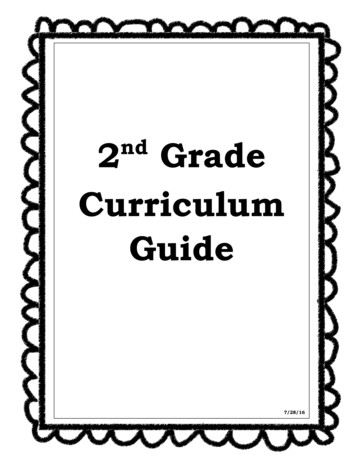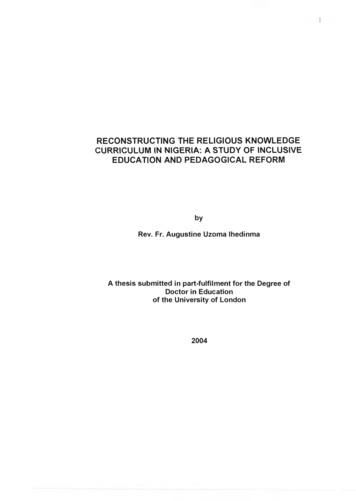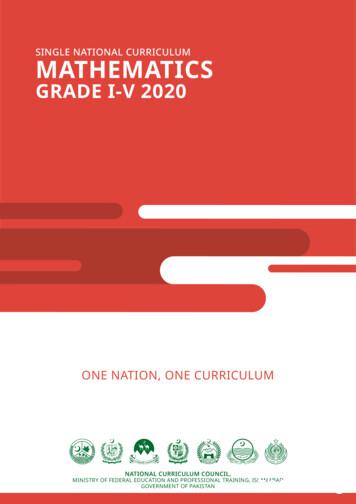Curriculum Guide
2 GradeCurriculumGuidend7/28/16
CVSD ELA Scope and Sequence2nd GradeUnitsTimelineUnit 1:Trimester 1InformationalUnit 2:LiteratureUnit 3:InformationalUnit 4:LiteratureUnit 5:InformationalUnit 6:LiteratureTrimester 1Trimester 2Trimester 2Trimester 3Trimester 3Reading InformationalText and LiteratureWritingFoundational Skills andSpeaking/ListeningPriority Standards1.2.2.B1.2.2.E1.2.2.KPriority StandardsW.2.2W.2.5L.2.2Priority 1.3.2.IW.2.3W.2.5L.2.1L.2.21.1.2.D1.1.2.E
ELA Priority Standards Grade 2CCSSPA CoreFoundational SkillsRF.2.3Know and apply grade level phonics and word analysis skills in decoding words. Distinguish long and short vowels when reading regularly spelled one- syllable words. Decode two-syllable words with long vowels and words with common prefixes and suffixes.CC.1.1.2.D Read grade level high-frequency sight words and words with inconsistent but common spellingsound correspondences. Read grade-appropriate irregularly spelled words.RF.2.4Read with accuracy and fluency to support comprehension: Read on-level text with purpose and understanding.CC.1.1.2.E Read on-level text orally with accuracy, appropriate rate, and expression on successive readings. Use context to confirm or self-correct word recognition and understanding, rereading as necessary.RI.2.2Reading Informational TextIdentify the main idea of a multi- paragraph text as well as the focus of specific paragraphs withinCC.1.2.2.Athe .2.5L.2.1L.2.2Ask and answer questions such as who, what, where, when, why, and how to demonstrateunderstanding of key details.Describe the connection between a series of events, concepts, or steps in a procedure within a text.Use various text features and search tools to locate key facts or information in a text efficiently.Determine or clarify the meaning of unknown and multiple-meaning words and phrases based ongrade-level reading and content, choosing from a range of strategies and tools.Reading LiteratureRecount stories and determine their central message, lesson, or moral.Ask and answer questions such as who, what, where, when, why, and how to demonstrateunderstanding of key details.Acknowledge differences in the points of views of characters, including by speaking in a differentvoice for each character when reading dialogue aloud.Determine or clarify the meaning of unknown and multiple-meaning word and phrases based ongrade level reading and content, choosing from a range of strategies and tools.WritingWrite opinion pieces in which they introduce the topic or book they are writing about, state anCC.1.4.2.G- opinion, supply reasons that support the opinion, use linking words (e.g., because, and, also) toJconnect opinion and reasons, and provide a concluding statement or section.CC.1.4.2.A- Write informative/explanatory texts in which they introduce a topic, use facts and definitions todevelop points, and provide a concluding statement or section.DWrite narratives in which they recount a well-elaborated event or short sequence of events, includeCC.1.4.2.M- details to describe actions, thoughts, and feelings, use temporal words to signal event order, andPprovide a sense of closure.CC.1.4.2.TWith guidance and support from adults and peers, focus on a topic and strengthen writing as neededby revising and editing.Demonstrate command of the conventions of standard English grammar and usage when writing orspeaking.a. Use collective nouns (e.g., group).b. Form and use frequently occurring irregular plural nouns (e.g., feet, children, teeth, mice, fish).CC.1.4.2.F, c. Use reflexive pronouns (e.g., myself, ourselves).L&Rd. Form and use the past tense of frequently occurring irregular verbs (e.g., sat, hid, told).e. Use adjectives and adverbs, and choose between them depending on what is to be modified.f. Produce, expand, and rearrange complete simple and compound sentences (e.g., The boy watchedthe movie; The little boy watched the movie; The action movie was watched by the little boy.)Demonstrate command of the conventions of standard English capitalization, punctuation, andspelling when writing.CC.1.4. F, L a. Capitalize holidays, product names, and geographic names.&Rb. Use commas in greetings and closings of letters.c. Use an apostrophe to form contractions and frequently occurring possessives.
CVSD ELA Curriculum Map 2nd GradeCommon Core StateStandardR.F.2.3PA Core StandardCC.1.1.2.D - Know and apply grade level phonics and word analysis skills indecoding words. Distinguish long and short vowels when reading regularly spelled onesyllable words. Decode two-syllable words with long vowels and words with commonprefixes and suffixes. Read grade level high-frequency sight words and words with inconsistentbut common spelling-sound correspondences. Read grade-appropriate irregularly spelled words.Taught in Unit(s)Units 1,2,3,4,5,6Explanation/Example of StandardStudents continue learning specific strategies for decoding words in texts. Learning prefixes, suffixes andvowel patterns enhances decoding, spelling ability, and vocabulary development. Use questions andprompts such as:Does that sound right?Does that look right?Does that make sense?Look for chunks you know and say themLook at the beginning of that word and try it againLook at the end of the word and try it againAre there are any patterns you can use to help you write the word?Common Misconceptionsdifference between learning word patterns, phonics rules, and irregularly spelled wordsBig Idea(s)Good readers use what they know about words andletter sounds to help them read.Essential Question(s)How can I use what I know about words andletter sounds to help me read?How do I know if a word has a short vowel orlong vowel in it?How do I decode two-syllable words to help meread?See unit map for specific unit common assessmentsConcepts(what students need to know)VowelsPrefixesSuffixesSyllablesSight WordsIrregularly Spelled WordsSpelling sound correspondencesSkills(what students must be able to do)Decode long and short vowel, one-syllable wordswith regular spellingsDecode two-syllable words with long vowelsDecode words with common prefixes andsuffixesDecode high-frequency sight wordsDecode words with inconsistent, but common
spelling-sound correspondencesDecode 2nd grade word wall words (irregularlyspelled words)I Can StatementsI know the difference between long and short vowels.I can read second grade words.I can read prefixes and suffixes.I know how to spell second grade words.
CVSD ELA Curriculum Map 2nd GradeCommon Core StateStandardPA Core StandardCC.1.1.2.E - Read with accuracy and fluency to support comprehension:RF.2.4 Read on-level text with purpose and understanding. Read on-level text orally with accuracy, appropriate rate, and expression onsuccessive readings. Use context to confirm or self-correct word recognition and understanding,rereading as necessary.Taught in Unit(s)Units 1-6Explanation/Example of StandardFluency helps the reader process language for meaning and enjoyment. Fluent readers are able to focusattention on the meaning of the text. Readers at this stage benefit from opportunities to read texts multipletimes at an independent level. Use questions and prompts such as: Make your reading sound like the characters are talking.Make your voice go up when you see the question mark at the end.Make your voice go down when you see the period at the end.Go back and reread when it doesn’t sound or look like you think it should.Common Misconceptions Fluency should not be taught in isolation Accuracy and speed are both important. Fast readers are not necessary fluent readers.Big Idea(s)Reading fluently helps a reader understand the text. Essential Question(s)What does it mean to read fluently?Why is it important to become a fluent reader?AssessmentsSee unit map for specific unit common assessments Concepts(what students need to Nonfiction Text Skills(what students must be able to do)Read with accuracyRead with appropriate rateRead with expression based on punctuation andcharactersSelf-correct while readingDescribe purpose for reading textI Can StatementsI can read passages fluently with changes in my voice, timing and expression.
CVSD ELA Curriculum Map 2nd GradeCommon Core StateStandardRI.2.2PA Core StandardCC.1.2.2.A – Identify the main idea of a multiparagraph text as well as thefocus of specific paragraphs within a text.Taught in Unit(s)Unit 3 and Unit 5Explanation/Example of StandardStudents are required to be able to read several paragraphs and identify the main idea. Along withrecognizing main idea, students need to be able to understand the overall focus of a text with severalparagraphs. Use questions and prompts such as:What is the main idea of this text?What are the important ideas in this text? How do you know?Common MisconceptionsA paragraph can only have one main idea.Main idea is the same as central message.Topic is the same as main idea.Big Idea(s)Authors of informational texts include key details inorder to help readers make meaning of the text.Good readers use key details in an informational textto identify the main topic.Informational texts can have multiple paragraphsthat work together to inform readers about a topic.Essential Question(s)How do authors of informational text helpreaders make meaning of the text?How do good readers identify the main topic ininformational textHow do multiple paragraphs in a text informreaders about a topic?AssessmentsSee unit map for specific unit common assessmentsConcepts(what students need to know)Informational text (both literary nonfiction andexpository/technical texts)Main ideaDifference between the main idea and key detailsFocus of specific paragraphsSkills(what students must be able to do)Identify the main idea of a multiparagraphinformational textIdentify the focus of specific paragraphs withinan informational textDescribe or graphically represent therelationship between main idea and focus ofspecific paragraphsI Can StatementsI can find the main ideas and supporting ideas in informational text.I can find the focus of specific paragraphs within an informational text.
CVSD ELA Curriculum Map 2nd GradeCommon Core StateStandardRI.2.1PA Core StandardCC.1.2.2.B – Ask and answer questions such as who, what, where, when, why,and how to demonstrate understanding of key details.Taught in Unit(s)Unit 1 and Unit 5Explanation/Example of StandardStudents are required to use textual evidence to ask and answer general questions about key details usingwho, what, when, where, why, and how. Use a question and prompt such as:Think about what you read and create your own questions (using who, what, when, where, why,and/or how) about an important idea in this text.Common MisconceptionsKey details are what I find most interesting.Questions can be answered with a “yes” or “no”.All questions are good questions.Big Idea(s)Authors include key details in informational textswhich can help a reader ask and answer questions.Essential Question(s)Why do authors include key details ininformational text?How do good readers use questions tounderstand key details in text?Good readers answer who, what, where, when, whyand how questions about a text in order todemonstrate an understanding of key details.AssessmentsSee unit map for specific unit common assessmentsConcepts(what students need to know)TextsQuestionsAnswersKey detailsPredictionsInferencesBackground knowledge5 Ws H questions (who, what where, when,why & how)Skills(what students must be able to do)Make reasonable predictions as they readUse information from the text and backgroundknowledge to make inferencesDemonstrate understanding of key details in atext when asking and answering questionsAsk and answer questions which begin with who,what, where, when why, and howI Can StatementsI can tell who, what, where, when, why and how after reading nonfiction.I can ask who, what, where, when, why and how questions when reading a nonfiction text.
CVSD ELA Curriculum Map 2nd GradeCommon Core StateStandardRI.2.3PA Core Standard1.2.2.C – Describe the connection between a series of events, concepts, orsteps in a procedure within a text.Taught in Unit(s)Unit 3Explanation/Example of StandardStudents at this level are required to describe how historical events, scientific ideas or “how to” proceduresare linked together in a text. Use questions and prompts such as:Which step comes first? After that? What happened first? After that?Can you tell me how these ideas are the same? Can you tell me how they are different?Common MisconceptionsSequence is only shown in how-to steps and processes.Big Idea(s)Authors of informational texts produce texts thatfollow a series of events, ideas/concepts or steps in aprocedure.Essential Question(s)How can I use the events, ideas, or steps to createconnections to better understand informationaltext?Good readers understand the connections betweenevents, ideas/concepts or steps and use thoseconnections to better understand informationaltext(s).AssessmentsSee unit map for specific unit common assessmentsConcepts(what students need to know)Informational text (both literary nonfiction andexpository/technical texts)How to describeKey ideas/concepts, events, steps ininformational texts.Key features of content-specific texts (e.g.,science and historical texts) based on textfeatures (e.g., events, steps, procedures)Simple transition/linking words that showconnections (e.g., first, because, then, on theother hand) for informational texts.Connections (e.g., one piece of te
2nd Grade . ELA Priority Standards Grade 2 CCSS PA Core Foundational Skills RF.2.3 CC.1.1.2.D Know and apply grade level phonics and word analysis skills in decoding words. Distinguish long and short vowels when reading regularly spelled one- syllable words. Decode two-syllable words with long vowels and words with common prefixes and suffixes. Read grade level high-frequency .
3.0 TYPES OF CURRICULUM There are many types of curriculum design, but here we will discuss only the few. Types or patterns are being followed in educational institutions. 1. Subject Centred curriculum 2. Teacher centred curriculum 3. Learner centred curriculum 4. Activity/Experience curriculum 5. Integrated curriculum 6. Core curriculum 7.
the key recommendations made in the Curriculum Development Council's Senior Secondary Curriculum Guide (2009), Technology Education Key Learning Area Curriculum Guide (Primary 1-Secondary 3) (2002) and the final report on the Holistic Review of the School Curriculum Learning to Learn - The Way Forward in Curriculum Development (2001). The
1.6.1 A religious knowledge curriculum 26 1.6.2 A religious studies curriculum 27 1.6.3 A religious education curriculum 27 1.7 Religious knowledge and the national curriculum 29 1.8 Religious knowledge and the humanities 31 1.9 Conclusion 35 CHAPTER TWO: REVIEW OF THE RELIGIOUS KNOWLEDGE CURRICULUM IN NIGERIA 36 2.1 The development of the religious knowledge curriculum in 36 2.1.1 The .
Handbook for Curriculum Assessment Curriculum Assessment: An Overview What is curriculum assessment? Curriculum assessment is a process of gathering and analyzing information from multiple sources in order to improve student learning in sustainable ways. Why bother assessing curriculum? Curriculum assessment can serve several major purposes:
High-Quality High-Quality Curriculum Curriculum HOW TO OR DESIGN REVISE ADOPT CURRICULUM ALIGNED TO STUDENT SUCCESS ANGELA DI MICHELE LALOR LALOR ENSURING ENSURING ENSURING High-Q uality Curriculum HOW TO DESIGN, REVISE, OR ADOPT CURRICULUM ALIGNED TO STUDENT SUCCESS We know that curriculum is the core of the classroom experience, but what makes a
1.1 The Single National Curriculum Mathematics (I -V) 2020: 1.2. Aims of Mathematics Curriculum 1.3. Mathematics Curriculum Content Strands and Standards 1.4 The Mathematics Curriculum Standards and Benchmarks Chapter 02: Progression Grid Chapter 03: Curriculum for Mathematics Grade I Chapter 04: Curriculum for Mathematics Grade II
Early Childhood (K-3) Syllabus 1-4 The following diagram illustrates the connections among the Curriculum Framework, the progress maps, the Curriculum Framework Curriculum Guides and the K-10 syllabuses. Connections among the Curriculum Framework, the Curriculum Framework Progress Maps/Outcomes and Standards Framework, the Curriculum Framework Curriculum Guides and the Early Childhood (K-3 .
This CURRICULUM GUIDE is the lead document for planning, assessment, and curriculum work. NAVIGATING THE LCPS MATHEMATICS CURRICULUM GUIDE The Curriculum Guide is created to link different components of the guide to related information from the Virginia Department of Education, resources created by






















